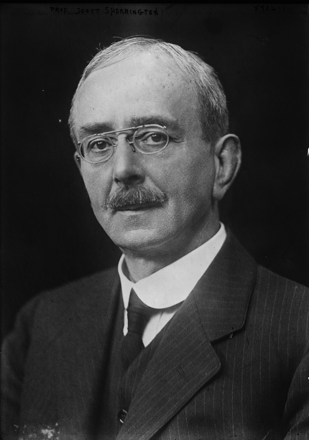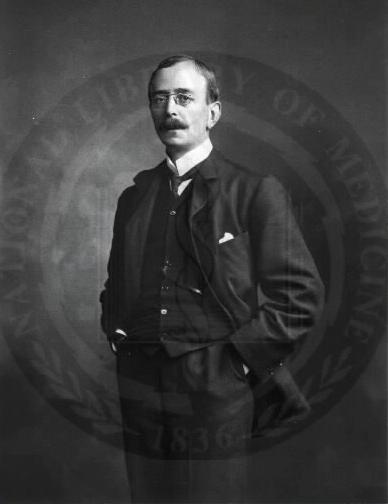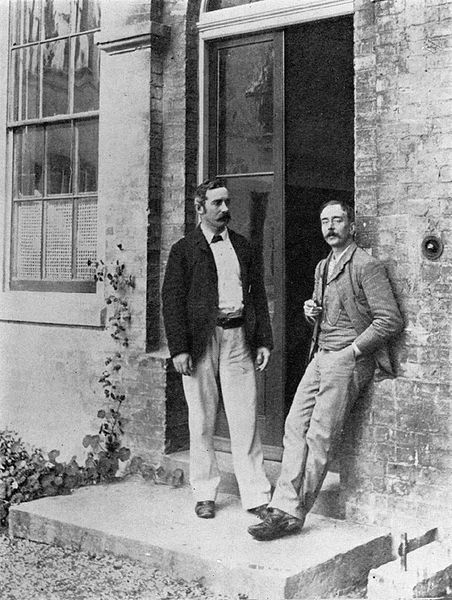<Back to Index>
- Neurophysiologist Charles Scott Sherrington, 1857
- Composer Julius Benedict, 1804
- Senator of the Philippines Benigno Simeon "Ninoy" Aquino, Jr., 1932
PAGE SPONSOR



Sir Charles Scott Sherrington, OM, GBE, PRS (27 November 1857 - 4 March 1952) was an English neurophysiologist, histologist, bacteriologist, and a pathologist, Nobel laureate and president of the Royal Society in the early 1920s. He received the Nobel Prize in Physiology or Medicine with Edgar Adrian, 1st Baron Adrian in 1932.
Charles Scott Sherrington was born in Islington, London, England on 27 November 1857. Although official biographies claimed that he was the son of James Norton Sherrington, a country doctor, and his wife Anne Brookes, née Thurtell, Charles and his brothers, William and George, were in fact almost certainly the illegitimate sons of Anne Brookes Sherrington and Caleb Rose, an eminent Ipswich surgeon. Caleb's father, Caleb Burrell Rose, was indeed a country doctor (in Swaffham, Norfolk) and was also a well known amateur geologist who published the first geological study of Norfolk. James Norton Sherrington, Anne Thurtell's first husband, was an iron monger and artist's colourman in Great Yarmouth, not a doctor, and died in Yarmouth in 1848, nearly 9 years before Charles was born. The births of the three Sherrington boys do not appear to have been officially registered and their baptism records have not yet been identified, but in the 1861 census the elder two were listed in the household of their mother, Anne Sherrington (widow) at 14 College Terrace, Islington, identified as Charles Scott (boarder, 4, born India) and William Stainton (boarder, 2, born Liverpool), while Caleb Rose was listed a visitor and his 11 year old son Edward Rose was also described as a boarder. On the night of the census Anne Sherrington must have been 4½ months pregnant with her third son, George, who was born in August 1861. During the 1860s the whole family moved to Anglesea Road, Ipswich, reputedly because London exacerbated Caleb Rose's tendency to asthma, and appeared in the census there in 1871, but Caleb and Anne were not actually married until the last quarter of 1880, following the death of Caleb's first wife, Isabella, in Edinburgh, Scotland, on 1 October 1880.
Caleb Rose was noteworthy as both a classical scholar and an archaeologist. At the family's Edgehill House in Ipswich one could find a fine selection of paintings, books, and geological specimens. Through Rose's interest in the English artists of the Norwich School, Sherrington gained a love of art. Intellectuals frequented the house regularly. It was this environment that fostered Sherrington's academic sense of wonder. Even before matriculation, the young Sherrington had read Johannes Müller's Elements of Physiology. The book was given to Sherrington by Caleb Rose.
Sherrington entered Ipswich School in 1871. Thomas Ashe, a famous English poet, worked at the school. Ashe served as an inspiration to Sherrington, the former instilling a love of classics and a desire to travel in the latter.
Rose had pushed Sherrington towards medicine. Sherrington first began to study with the Royal College of Surgeons of England. Sherrington also sought to study at Cambridge, but a bank failure had devastated the family's finances. Sherrington elected to enroll at St Thomas' Hospital in September 1876 as a "perpetual pupil". He did so in order to allow his two younger brothers to do so ahead of him. The two studied law there. Medical studies at St. Thomas's Hospital were intertwined with studies at Gonville and Caius College, Cambridge. Physiology was Sherrington's chosen major at Cambridge. There, he studied under the "father of British physiology," Sir Michael Foster.
Sherrington played football for his grammar school, and for Ipswich Town Football Club, rugby St. Thomas's, was on the rowing team at Oxford. During June 1875, Sherrington passed his preliminary examination in general education at the Royal College. This preliminary exam was required for Fellowship, and also exempted him from a similar exam for the Membership. In April 1878, he passed his Primary Examination for the Membership of the Royal College of Surgeons, and 12 months later the Primary for Fellowship.
In October 1879, Sherrington entered Cambridge as a non collegiate student. The following year he entered Gonville and Caius College. Sherrington was quite the student. Walter Holbrook Gaskell, one of Sherrington's tutors, informed him in November 1881 that he had earned the highest marks for his year in botany, human anatomy, and physiology; second in zoology; and highest overall. John Newport Langley was Sherrington's other tutor. The two were interested in how anatomical structure is expressed in physiological function.
Sherrington earned his Membership of the Royal College of Surgeons on 4 August 1884. In 1885, he obtained a First Class in the Natural Science Tripos with the mark of distinction. In the same year, Sherrington earned the degree of M.B., Bachelor of Medicine and Surgery from Cambridge. In 1886, Sherrington added the title of L.R.C.P., Licentiate of the Royal College of Physicians.
The conference was held in London in 1881. It was at this conference that Sherrington began his work in neurological research. At the conference controversy broke out. Friedrich Goltz of Strasbourg argued that localized function in the cortex did not exist. Goltz came to this conclusion after observing dogs who had parts of their brains removed. David Ferrier, who became a hero of Sherrington's, disagreed. Ferrier maintained that there was localization of function in the brain. Ferrier's strongest evidence was a monkey who suffered from hemiplegia, paralysis affecting one side of the body only, after a cerebral lesion.
A committee, including Langley, was made up to investigate. Both the dog and the monkey were chloroformed. The right hemisphere of the dog was delivered to Cambridge for examination. Sherrington performed a histological examination of the hemisphere, acting as a junior colleague to Langley. In 1884, Langley and Sherrington reported on their findings in a paper. The paper was the first for Sherrington.
In the Winter of 1884 - 1885, Sherrington left England for Strasbourg. There, he worked with Goltz. Goltz, like many others, positively influenced Sherrington. Sherrington later said of Goltz that: "[h]e taught one that in all things only the best is good enough."
A case of asiatic cholera had broken out in Spain in 1885. A Spanish physician claimed to have produced a vaccine to fight the outbreak. Under the auspices of Cambridge University, the Royal Society of London, and the Association for Research in Medicine, a group was put together to travel to Spain to investigate. C.S. Roy, J. Graham Brown, and Sherrington formed the group. Roy was Sherrington's friend and the newly elected professor of pathology at Cambridge. As the three traveled to Toledo, Sherrington was skeptical of the Spanish physician. Upon returning, the three presented a report to the Royal Society. The report discredited the Spaniard's claim.
It should be mentioned that Sherrington did not meet Santiago Ramón y Cajal on this trip. While Sherrington and his group remained in Toledo, Cajal was hundreds of miles away in Zaragoza.
Later that year Sherrington traveled to Rudolf Virchow in Berlin to inspect the cholera specimens he procured in Spain. Virchow later on sent Sherrington to Robert Koch for a six weeks' course in technique. Sherrington ended up staying with Koch for a year to do research in bacteriology. Under these two, Sherrington parted with a good foundation in physiology, morphology, histology, and pathology. During this period he may have also studied with Waldeyer and Zuntz.
In 1886, Sherrington went to Italy to again investigate a cholera outbreak. While in Italy, Sherrington spent much time in art galleries. It was in this country that Sherrington's love for rare books became an addiction.
In
1891, Sherrington was appointed as superintendent of the Brown
Institute for Advanced Physiological and Pathological Research of the
University of London, a center for human and animal physiological and
pathological research. Sherrington succeeded Sir Victor Alexander Haden Horsley. There,
Sherrington worked on segmental distribution of the spinal dorsal and
ventral roots, he mapped the sensory dermatomes, and in 1892 discovered
that muscle spindles initiated the stretch reflex. The institute
allowed Sherrington to study many animals, both small and large. The
Brown Institute had enough space to work with large primates such as
apes.
Sherrington's first job of full professorship came with his appointment as Holt Professor of Physiology at Liverpool in 1895, succeeding Francis Gotch. With his appointment to the Holt Chair, Sherrington ended his active work in pathology. Working on cats, dogs, monkeys, and apes that had been bereaved of their cerebral hemispheres, he found that reflexes must be considered integrated activities of the total organism, not just the result of activities of the so-called reflex - arcs, a concept then generally accepted. There he continued his work on reflexes and reciprocal innervation. His papers on the subject were synthesized into the Croonian lecture of 1897.
Sherrington showed that muscle excitation was inversely proportional to the excitation of an opposing group of muscles. Speaking of the excitation - inhibition relationship, Sherrington said "desistence from action may be as truly active as is the taking of action." Sherrington continued his work on reciprocal innervation during his years at Liverpool. Come 1913, Sherrington was able to say that "the process of excitation and inhibition may be viewed as polar opposites [...] the one is able to neutralize the other." Sherrington's work on reciprocal innervation was a notable contribution to the knowledge of the spinal cord.
As early as 1895, Sherrington had tried to gain employment at Oxford University. By 1913, the wait was over. Oxford offered Sherrington the Waynflete Chair of Physiology. The electors to that chair unanimously recommended Sherrington without considering any other candidates. Sherrington enjoyed the honor of teaching many bright students at Oxford. Over a handful of his students were Rhodes' scholars and three went on to be Nobel laureates. The three are Sir John Eccles, Ragnar Granit, and Howard Florey.
Sherrington's philosophy as a teacher can be seen in his response to the question of what was the real function of Oxford University in the world. Sherrington said:
"after some hundreds of years of experience we think that we have learned here in Oxford how
to teach what is known. But now with the undeniable upsurge of scientific research, we cannot
continue to rely on the mere fact that we have learned how to teach what is known. We must learn
to teach the best attitude to what is not yet known. This also may take centuries to acquire but we
cannot escape this new challenge, nor do we want to."
Sherrington's teachings at Oxford were interrupted by World War I. When the war started, it left his classes with only nine students. During the war, he laboured at a shell factory to support the war and to study fatigue in general, but specifically industrial fatigue. His weekday work hours were from 07:30 a.m to 08:30 p.m.; and 07:30 a.m. to 06:00 p.m. on the weekends.
In March 1916, Sherrington fought for women to be able to be admitted to the medical school at Oxford. Charles Sherrington retired from Oxford in the year of 1936. He then moved to his boyhood town of Ipswich, where he built a house. There, he kept up a large correspondence with pupils and others from
around the world. He also continued to work on his poetic, historical,
and philosophical interests. From 1944 until his own death he was President of the Ipswich Museum, on the committee of which he had previously served. Sherrington's
mental faculties were crystal clear up to the time of his death, which
was caused by a sudden heart failure and ended his life instantly. His
bodily health, however, did suffer in old age. Rheumatoid arthritis was
a major burden of his. Speaking of his condition, Sherrington said "old age isn't pleasant[,] one can't do things for oneself." The arthritis put Sherrington in a nursing home as late as 1951.
On
27 August 1891, Sherrington married Ethel Mary Wright. Wright was the
daughter of John Ely Wright of Preston Manor, Suffolk, England.
Sherrington and Wright had one child, a son named Carr E.R. Sherrington
who was born in 1897. Wright
was both loyal and lively. She was a great host. On weekends during the
Oxford years the couple would frequently host a large group of friends
and acquaintances at their house for an enjoyable afternoon.